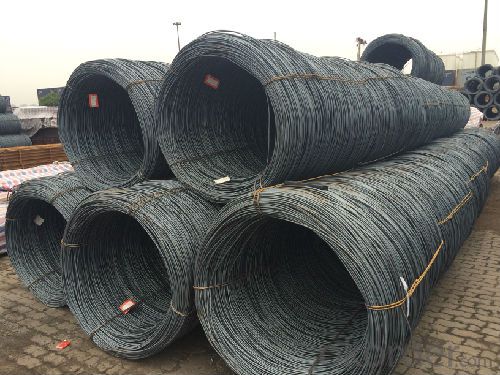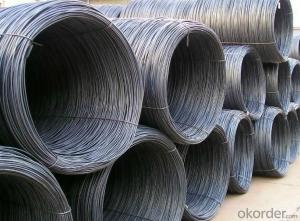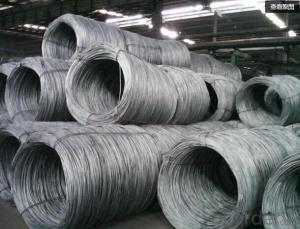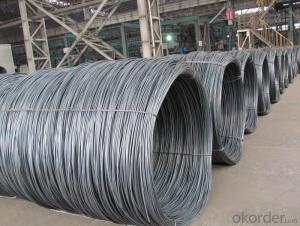Hot Rolled Steel Wire Rod in Coils SAE1008B
- Loading Port:
- Tianjin
- Payment Terms:
- TT OR LC
- Min Order Qty:
- 30 m.t.
- Supply Capability:
- 20000 m.t./month
OKorder Service Pledge
OKorder Financial Service
You Might Also Like
Item specifice
Product Description:
OKorder is offering Hot Rolled Steel Wire Rod in Coils SAE1008B at great prices with worldwide shipping. Our supplier is a world-class manufacturer of steel, with our products utilized the world over. OKorder annually supplies products to African, South American and Asian markets. We provide quotations within 24 hours of receiving an inquiry and guarantee competitive prices.
Product Applications:
Hot Rolled Steel Wire Rod in Coils SAE1008B are ideal for structural applications and are widely used in construction and manufacturing. Carbon steel wire rod is mainly used for reinforcement of reinforced concrete and welded structure or reprocessed (roberts , nail, etc.) materials, especially used to produce wire drawing, welding electrode, nails, spring, electronic, precise machinery parts and so on.
Product Advantages:
OKorder's Hot Rolled Steel Wire Rod in Coils SAE1008B are durable, strong, and wide variety of sizes. They are newly produced by good quality steel billets.
Main Product Features:
· Premium quality
· Prompt delivery & seaworthy packing (30 days after receiving deposit)
· Can be recycled and reused
· Mill test certification
· Professional Service
· Competitive pricing
Product Specifications:
Steel Grade: SAE1006-1018B
Standard: ASTM, GB
Diameter: 5.5mm, 6.5mm, 7mm,8mm,9mm,10mm,12mm,14mm
Type: in coil, coil weight around 2MT
Alloy or Not: Alloy
Technique: Hot Rolled
Place of Origin: China Mainland
Surface: round, no twisted, light and smooth
FAQ:
Q1: Why buy Hot Rolled Steel Wire Rod in Coils SAE1008B from OKorder.com?
A1: All products offered byOKorder.com are carefully selected from China's most reliable manufacturing enterprises. Through its ISO certifications, OKorder.com adheres to the highest standards and a commitment to supply chain safety and customer satisfaction.
Q2: How do we guarantee the quality of our products?
A2: We have established an advanced quality management system which conducts strict quality tests at every step, from raw materials to the final product. At the same time, we provide extensive follow-up service assurances as required.
Q3: How soon can we receive the product after purchase?
A3: Within three days of placing an order, we will arrange production. The normal sizes with the normal grade can be produced within one month. The specific shipping date is dependent upon international and government factors, the delivery to international main port about 45-60days.
Images:


- Q:What are the common heat treatment processes for steel wire rod?
- The common heat treatment processes for steel wire rod include annealing, normalizing, quenching, and tempering.
- Q:What are the safety considerations when handling steel wire rods?
- To ensure safety when dealing with steel wire rods, there are several crucial factors to bear in mind. 1. Personal Protective Equipment (PPE): It is imperative to don the appropriate PPE to safeguard oneself against potential hazards. This may encompass safety glasses, gloves, and steel-toed boots to prevent injuries from falling rods or accidental contact. 2. Proper Lifting Techniques: Given that steel wire rods can be heavy and unwieldy, it is vital to employ proper lifting techniques, such as bending the knees and using the legs to lift, in order to prevent strains or back injuries. 3. Storage and Handling: Steel wire rods should be stored in a designated, well-organized, and secure area. They should be stacked in a stable manner to avert any toppling and resulting injuries. Furthermore, it is crucial to ensure that the rods are shielded from moisture or extreme temperatures, as these factors can compromise their integrity. 4. Sharp Edges and Points: Steel wire rods often possess sharp edges and points, which can lead to cuts or puncture wounds. Handling them with care and utilizing appropriate tools, such as wire cutters or pliers, can help avoid direct contact with these sharp areas. 5. Transport and Loading: When transporting or loading steel wire rods, it is vital to adequately secure them to prevent shifting or falling during transit. This may involve utilizing suitable tie-downs, straps, or other restraints to keep the rods in place. 6. Training and Awareness: It is essential that all individuals involved in handling steel wire rods receive proper training on safe handling procedures and are aware of potential hazards. Regular safety meetings and reminders can effectively reinforce the significance of adhering to safety protocols. By taking these safety measures into consideration, one can help mitigate the risks associated with handling steel wire rods and ensure a safe working environment for all parties involved.
- Q:How is steel wire rod used in the manufacturing of wire for shopping baskets?
- Steel wire rod is an essential component in the manufacturing of wire for shopping baskets. It serves as the raw material that is transformed into wire through a series of manufacturing processes. The steel wire rod is first heated and then passed through a series of rollers to gradually reduce its thickness and increase its length. This process is known as drawing and it helps to improve the tensile strength and flexibility of the wire. Once the wire is drawn, it is typically coated with a protective layer to prevent corrosion and enhance its durability. This coating can be made of materials such as zinc or plastic. The coated wire is then shaped into the desired form, which in the case of shopping baskets, is usually a mesh-like structure. This shaping is done through a process called welding, where the wire is bent and joined at specific points to form the basket shape. The steel wire rod used in the manufacturing of wire for shopping baskets is chosen for its strength, resilience, and ability to withstand heavy loads. It ensures that the shopping baskets are sturdy enough to carry various items without bending or breaking. Additionally, the steel wire rod's corrosion resistance properties ensure that the wire and ultimately the shopping baskets have a longer lifespan, even when exposed to moisture or harsh environments. In summary, steel wire rod plays a crucial role in the manufacturing of wire for shopping baskets. It provides the raw material needed to produce the wire, which is then coated, shaped, and welded to create the final product. The strength, resilience, and corrosion resistance of the steel wire rod ensure that the shopping baskets are durable, long-lasting, and capable of withstanding the demands of everyday use.
- Q:How is the steel wire rod market expected to grow in the future?
- The steel wire rod market is expected to grow significantly in the future due to several key factors. Firstly, the increasing demand for steel wire rods in various industries such as construction, automotive, and manufacturing is expected to drive market growth. Steel wire rods are essential for applications such as reinforcement in concrete structures, wire mesh for fencing, and manufacturing of automobile parts. Additionally, the rising urbanization and industrialization in developing economies are likely to fuel the demand for steel wire rods. As these countries continue to invest in infrastructure development and construction projects, the need for steel wire rods will grow substantially. Moreover, the automotive industry's shift towards electric vehicles and lightweight materials is expected to further boost the demand for steel wire rods as they are crucial for producing lightweight yet strong components. Furthermore, advancements in technology and innovation in steel manufacturing processes are anticipated to positively impact the market growth. These advancements allow for the production of high-quality steel wire rods that meet the specific requirements of various industries. Additionally, the implementation of stringent safety and quality standards by regulatory bodies is expected to drive the demand for premium-grade steel wire rods. Moreover, the growing focus on sustainable and eco-friendly construction practices is likely to contribute to market growth. Steel wire rods are recyclable, making them a preferred choice in environmentally conscious projects. Furthermore, the increasing adoption of steel wire rods in the renewable energy sector, particularly wind energy, is expected to create new growth opportunities for the market. In conclusion, the steel wire rod market is expected to witness significant growth in the future, driven by increasing demand from various industries, urbanization, technological advancements, and the focus on sustainable practices.
- Q:How is steel wire rod recycled or disposed of?
- Steel wire rod can be recycled through a process called steel melting, where it is melted down and transformed into new steel products. Alternatively, if the wire rod is no longer suitable for recycling, it can be disposed of in landfills or sent to scrap metal yards for proper disposal.
- Q:How is the bending properties of steel wire rod tested?
- The bending properties of steel wire rod are typically tested through a method called the bend test. In this test, a sample of the wire rod is bent to a specific angle or curvature and then examined for any signs of cracking or breaking. The test is conducted by securing one end of the wire rod and applying a force to the other end to bend it. The amount of force required to achieve the desired bend is measured, and the wire rod is visually inspected for any signs of deformation or fracture. Additionally, the test may involve measuring the diameter of the wire rod before and after bending to assess any changes in its physical properties. The bend test provides valuable information about the flexibility and ductility of the steel wire rod, which is crucial in determining its suitability for various applications.
- Q:How is steel wire rod priced in the market?
- Steel wire rod is priced in the market based on various factors that influence its production and demand. These factors include the cost of raw materials, such as iron ore and scrap metal, as well as the cost of energy and labor involved in the manufacturing process. Additionally, market conditions and supply and demand dynamics also play a significant role in determining the price of steel wire rod. Factors such as global economic conditions, trade policies, and infrastructure development projects can impact the demand for steel wire rod, thereby affecting its price. Steel wire rod is often traded on commodity exchanges, where market participants engage in buying and selling contracts based on future delivery dates. The price of steel wire rod on these exchanges is influenced by factors such as market speculation, storage costs, and transportation expenses. Furthermore, the quality and specifications of the steel wire rod also influence its price. Different grades, sizes, and coatings of steel wire rod have varying prices based on their suitability for different applications and industries. Overall, steel wire rod prices are determined by a combination of factors including raw material costs, production expenses, market conditions, supply and demand dynamics, quality specifications, and trading activities on commodity exchanges.
- Q:How is steel wire rod used in the manufacturing of wire forms for jewelry findings?
- Steel wire rod is an essential component in the manufacturing of wire forms for jewelry findings. It serves as the primary raw material that is transformed into various shapes and sizes to create different types of wire forms. The first step in utilizing steel wire rod for jewelry findings is to determine the required diameter and length of the wire. This is crucial as it determines the strength and flexibility of the final product. Once the specifications are established, the steel wire rod is cut into smaller sections, which are then straightened and polished. After the initial preparation, the wire rod is shaped and manipulated using specialized tools and techniques. For example, it can be bent, twisted, or coiled to create different wire forms such as jump rings, ear wires, clasps, and connectors. These wire forms are integral parts of jewelry findings, which are the small components that hold jewelry pieces together. The use of steel wire rod in manufacturing wire forms for jewelry findings offers several advantages. Firstly, steel is a durable and robust material, providing strength and stability to the final product. This ensures that the wire forms can withstand the rigors of everyday wear and tear. Additionally, steel wire rod is resistant to corrosion, making it suitable for long-lasting jewelry pieces. Moreover, steel wire rod allows for a wide range of design possibilities. It is highly malleable and can be easily shaped into intricate patterns and designs, adding aesthetic appeal to the jewelry findings. The versatility of steel wire rod enables jewelry designers to create unique and customized wire forms that suit individual preferences. In conclusion, steel wire rod is an essential component in the manufacturing of wire forms for jewelry findings. Its strength, durability, resistance to corrosion, and malleability make it an ideal material for creating various wire forms such as jump rings, ear wires, clasps, and connectors. By utilizing steel wire rod, jewelry manufacturers can produce high-quality and aesthetically pleasing jewelry findings that enhance the overall design and functionality of jewelry pieces.
- Q:How is steel wire rod stored to prevent corrosion?
- Steel wire rods are typically stored in a way that minimizes the risk of corrosion. One common method is to store the rods in a well-ventilated area with controlled humidity levels. This helps to prevent the build-up of moisture, which can accelerate the corrosion process. Another preventive measure is to store the steel wire rods in a dry environment and off the ground. This can be achieved by placing the rods on pallets or racks, ensuring that they are not in direct contact with the floor. By keeping the rods elevated, any potential moisture or water accumulation on the ground is avoided. Furthermore, steel wire rods can be stored indoors in a climate-controlled warehouse. Maintaining a stable temperature and humidity level can significantly reduce the chances of corrosion. These controlled environments help to minimize moisture exposure and prevent the formation of rust on the wire rods. In addition to these storage practices, coating the steel wire rods with a protective layer is also a common preventive measure. This can be done by applying a corrosion-resistant coating such as zinc or epoxy. The coating acts as a barrier between the rods and the surrounding environment, preventing moisture from reaching the surface of the wire rods and causing corrosion. Overall, proper storage of steel wire rods involves minimizing moisture exposure, maintaining controlled humidity levels, keeping the rods off the ground, and using protective coatings. By implementing these measures, the risk of corrosion is significantly reduced, ensuring that the steel wire rods remain in optimal condition until they are ready for use.
- Q:What is the average diameter of steel wire rod?
- The average diameter of steel wire rod varies depending on its intended application and industry standards. However, it typically ranges from 5.5 millimeters to 14 millimeters.
1. Manufacturer Overview |
|
|---|---|
| Location | |
| Year Established | |
| Annual Output Value | |
| Main Markets | |
| Company Certifications | |
2. Manufacturer Certificates |
|
|---|---|
| a) Certification Name | |
| Range | |
| Reference | |
| Validity Period | |
3. Manufacturer Capability |
|
|---|---|
| a)Trade Capacity | |
| Nearest Port | |
| Export Percentage | |
| No.of Employees in Trade Department | |
| Language Spoken: | |
| b)Factory Information | |
| Factory Size: | |
| No. of Production Lines | |
| Contract Manufacturing | |
| Product Price Range | |
Send your message to us
Hot Rolled Steel Wire Rod in Coils SAE1008B
- Loading Port:
- Tianjin
- Payment Terms:
- TT OR LC
- Min Order Qty:
- 30 m.t.
- Supply Capability:
- 20000 m.t./month
OKorder Service Pledge
OKorder Financial Service
Similar products
New products
Hot products
Related keywords




























